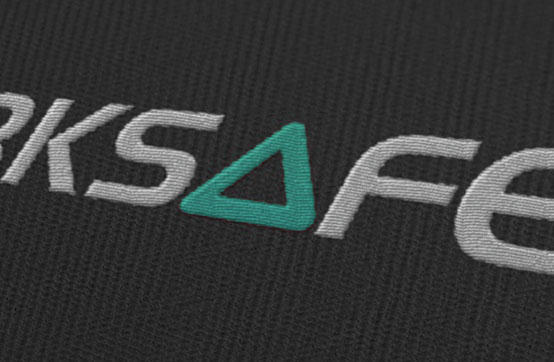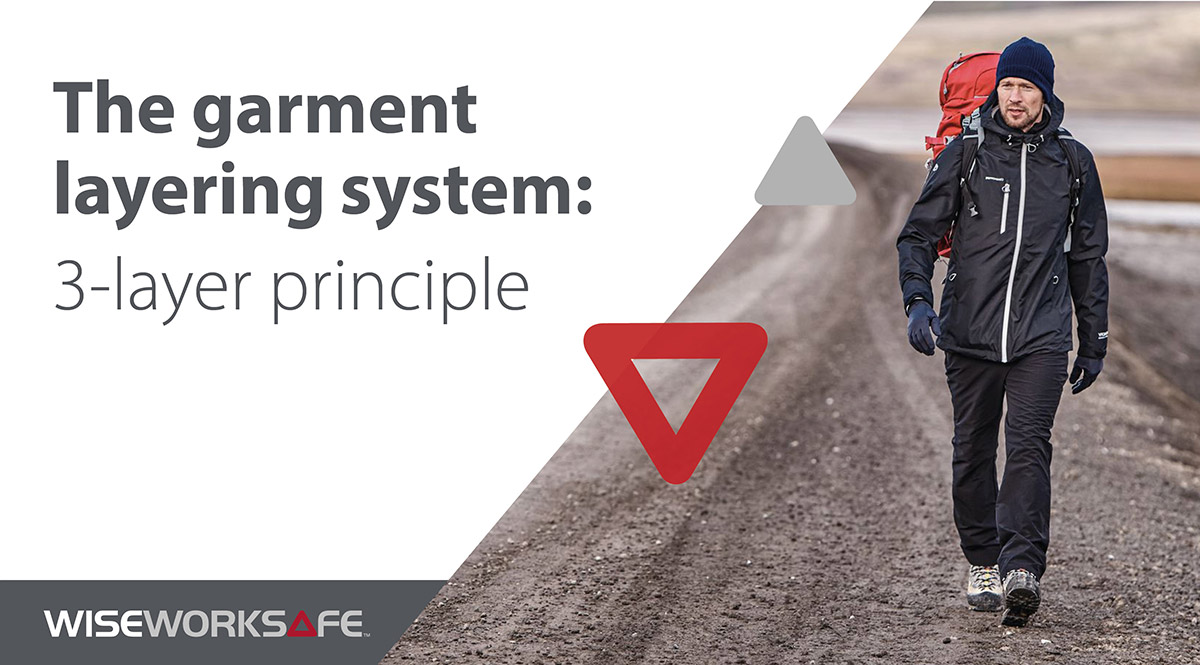
The Garment Layering System: 3-layer Principle
There are many ways of achieving a good level of comfort, warmth and weather protection with outdoor clothing. However, intelligent layering allows people to adapt their clothing to suit both the weather conditions and the activity being carried out. Dressing according to the 3-layer principle is an established norm for a large number of outdoor sporting and recreational activities, but what about at work? Using this garment layering system is a smart and effective way to keep workers warm and dry through varying conditions and fluctuation in activity intensity.
This guide is an introduction to how you can apply the 3-layer principle to protect outdoor workers and ensure they’re correctly equipped for every season.
What is the 3-layer principle?
The 3-layer principle is a clothing system consisting of three garment layers of the right materials and design, which can be added or removed based on weather conditions and activity.
The three layers are made up of:
Layer 1: Base Layer - Transportation
This is the wicking layer which transports away moisture from the skin and helps regulate body temperature. Sweat goes through the next layer of clothing so the base stays dry.
Layer 2: Mid Layer - Insulation
Mid layer garments have insulating properties which trap the warmth the body generates.
Layer 3: Outer Layer - Protection
This is the protective layer against external influences and weather conditions. For example, a waterproof jacket for rain or a windproof or down jacket for protection against cold.
Why use the garment layering system?
When working outdoors, workers often produce surplus heat as they carry out their tasks, and their bodies will react to this by perspiring to regulate the body temperature. When this perspiration is able to evaporate, the body temperature lowers and the wearer can maintain an adequate level of comfort. However, if their workwear does not allow this evaporation to happen, it is likely to restrict the level of cooling and drying.
Although our natural reaction when the temperature drops may be to throw on the thickest clothing possible, this isn’t necessarily the best idea. This can be especially problematic if the wearer is switching between a mixture of tasks that vary in physical strain. By wearing multiple layers of clothing, workers will be able to make reasonable adjustments to their workwear when a change in the weather or their task occurs.
No two people will react to cold weather in the same way, so, for this reason, personal preference should be taken into account when choosing outdoor workwear. By encouraging the use of a garment layering system you can allow workers to tailor their clothing to their needs, although you also have to make sure this is still suitable within the safety parameters of their working environment.
Applying this system to outdoor work clothing is cost effective as it eliminates the need to purchase specific garments or outfits for different tasks. Workers can instead add or take away layers according to their activity level, weather conditions, and personal preference.
Examples of Base Layers
The base layer is one of the most integral pieces of clothing, forming the key foundation of the layering system and enabling employees to stay warm and dry. This layer is worn next to the skin, creating a thin layer of warm air against the body. It helps to transport moisture and sweat vapour from the skin to regulate the body’s temperature.
Common types of baselayers include leggings, long johns, and long or short sleeve thermal tops. In warmer conditions, this layer could simply be a basic vest, t-shirt or polo shirt, as technical thermal or wicking fabric properties are not necessarily needed in this case.
If the temperature or task is likely to cause excessive perspiration, it is best to avoid fabrics that soak up sweat and stay wet. Synthetic materials like wicking polyester fabric are excellent at moving moisture away from the skin, helping it to evaporate. Another material option for the baselayer is wool, often the superior Merino wool. Whilst it is comfortable and has excellent wicking and anti-bacterial properties, wool does not dry as quickly and is less durable and more expensive than synthetics.
Examples of Mid Layers
The mid layer is often referred to as the ‘insulation layer’, and this is where warmth is built into the layering system. Common types of mid layers include fleeces, softshells, bodywarmers, sweatshirts or hoodies.
This layer is worn over the base layer to help trap in body heat, further transporting sweat away from the body to keep the wearer warm and dry. In milder conditions the mid layer could also act as the outer layer, but bear in mind that these garments are often not designed to protect against rain, wind or other external influences.
Examples of Outer Layers
The outer layer is crucial for when the wearer needs protection against the elements, including wind, rain and snow. This layer is normally lightweight and waterproof, and breathability is also highly recommended. These garments stop the elements from entering while avoiding overheating by allowing moisture and heat from the body to escape.
There are different types of outer layer, as detailed below:
These are breathable water resistant jackets, designed to defend against the most adverse conditions. They must have taped seams and suitable weather protection zips to be fully waterproof.
Depending on the weather conditions, the outer layer doesn’t necessarily have to be fully waterproof; water repellency may be sufficient. Soft shells provide excellent comfort, good wind resistance, and are sometimes more breathable than waterproofs. They can also act as an effective mid layer in cooler weather conditions when combined with a waterproof outer layer.
Insulated jackets
When working in very cold conditions an insulated or synthetic jacket can be a highly effective outer layer. However, it’s wise to have alternative layering options in case activity levels or weather conditions fluctuate.
Dressing according to the level of activity
High intensity activities will generate body heat and sweat, so it’s necessary to wear clothing that is breathable, moisture-wicking, and has good temperature regulation properties. A good layering system for high intensity work might include a light baselayer, versatile mid layer (in case they need to remove their outer due to overheating), and a softshell outer layer.
Low intensity activities are likely to require clothing that offers weather protection, insulation and core warmth as the body will not be producing as much heat. For these situations, it’s best to opt for a heavier baselayer, a warmer mid layer, and a waterproof outer shell.
What to wear in different weather conditions
Whilst the level of activity is a good starting point when choosing appropriate layers, weather conditions and temperature are also very important to consider. These factors can be unpredictable, which is why it’s helpful to encourage workers to bring layers with them so they can remove or swap pieces to change the dynamic of their layering system.
If it is very cold the wearer may need to choose a thicker baselayer or warmer/more insulated mid layer, even if they are participating in a high intensity activity. If it is wet and windy, workers will need to wear a hardshell and windproof layers regardless of the activity.
Here’s a quick guide to adjusting layers in different weather conditions:
|
Weather conditions |
Recommended layers |
|
Dry, sunny and calm |
Base layer, optional mid layer (sweatshirt) |
|
Lower temperatures, sunny and calm |
Base layer and mid layer (fleece or softshell) |
|
Warm and wet |
Base layer and outer layer (waterproof breathable jacket) |
|
Windy, cold and wet |
Base layer, mid layer (fleece or softshell) and outer layer (waterproof jacket) |
|
Windy, extremely cold, wet/snow |
Base layer, mid layer (fleece or insulated jacket) and outer layer (waterproof hard shell jacket) |
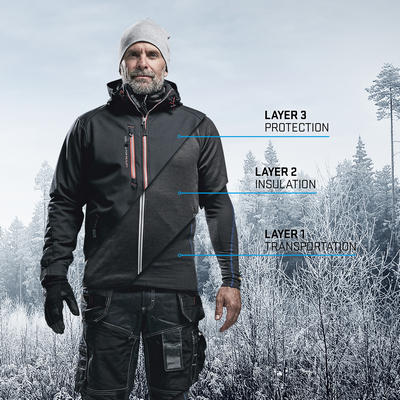
Three Layers: Light
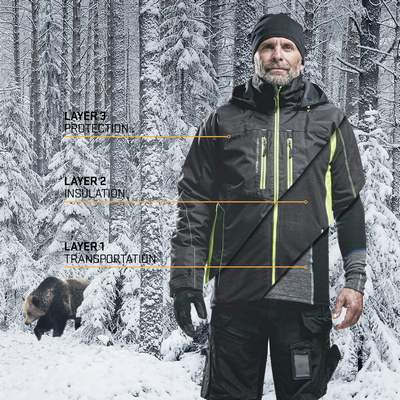
Three Layers: Warm
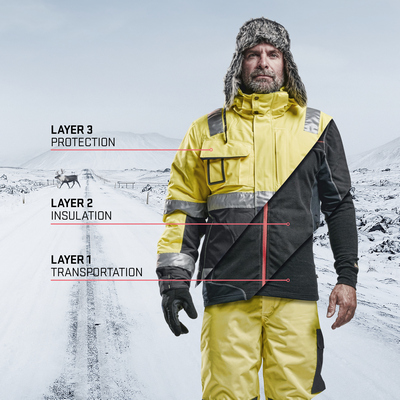
Three Layers: Extra Warm
For more guidance on how to protect workers in varying weather conditions, check out our guides on protecting outdoor workers in winter and protecting outdoor workers in hot weather.
 VIEW BASKET
VIEW BASKET




